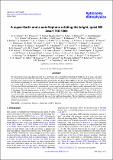A super-Earth and a sub-Neptune orbiting the bright, quiet M3 dwarf TOI-1266
Author(s)
Demory, B-O; Pozuelos, FJ; Gómez Maqueo Chew, Y; Sabin, L; Petrucci, R; Schroffenegger, U; Grimm, SL; Sestovic, M; Gillon, M; McCormac, J; Barkaoui, K; Benz, W; Bieryla, A; Bouchy, F; Burdanov, A; Collins, KA; ... Show more Show less
DownloadPublished version (11.32Mb)
Publisher Policy
Publisher Policy
Article is made available in accordance with the publisher's policy and may be subject to US copyright law. Please refer to the publisher's site for terms of use.
Terms of use
Metadata
Show full item recordAbstract
© 2020 ESO. We report the discovery and characterisation of a super-Earth and a sub-Neptune transiting the bright (K = 8.8), quiet, and nearby (37 pc) M3V dwarf TOI-1266. We validate the planetary nature of TOI-1266 b and c using four sectors of TESS photometry and data from the newly-commissioned 1-m SAINT-EX telescope located in San Pedro Mártir (México). We also include additional ground-based follow-up photometry as well as high-resolution spectroscopy and high-angular imaging observations. The inner, larger planet has a radius of R = 2.37-0.12+0.16 R and an orbital period of 10.9 days. The outer, smaller planet has a radius of R = 1.56-0.13+0.15 R on an 18.8-day orbit. The data are found to be consistent with circular, co-planar and stable orbits that are weakly influenced by the 2:1 mean motion resonance. Our TTV analysis of the combined dataset enables model-independent constraints on the masses and eccentricities of the planets. We find planetary masses of Mp = 13.5-9.0+11.0 M (<36.8 M at 2-σ) for TOI-1266 b and 2.2-1.5+2.0 M (<5.7 M at 2-σ) for TOI-1266 c. We find small but non-zero orbital eccentricities of 0.09-0.05+0.06 (<0.21 at 2-σ) for TOI-1266 b and 0.04 ± 0.03 (< 0.10 at 2-σ) for TOI-1266 c. The equilibrium temperatures of both planets are of 413 ± 20 and 344 ± 16 K, respectively, assuming a null Bond albedo and uniform heat redistribution from the day-side to the night-side hemisphere. The host brightness and negligible activity combined with the planetary system architecture and favourable planet-to-star radii ratios makes TOI-1266 an exquisite system for a detailed characterisation.
Date issued
2020Department
Massachusetts Institute of Technology. Department of Earth, Atmospheric, and Planetary Sciences; MIT Kavli Institute for Astrophysics and Space Research; Massachusetts Institute of Technology. Department of Aeronautics and AstronauticsJournal
Astronomy and Astrophysics
Publisher
EDP Sciences